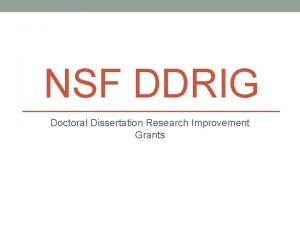1 st DFGGENI Doctoral Consortium San Juan PR

- Slides: 1

1 st DFG/GENI Doctoral Consortium, San Juan, PR March 13 th-15 th, 2011 GENI Experiments on P 2 P, MANET, WSN Networks Haiying (Helen) Shen, Kuang-Ching Wang , Kang Chen and Ke Xu Clemson University Abstract Research Objectives Today’s society is witnessing a tremendous increase in digital information. Myriads of applications call for the pooling and sharing of massive amounts of widely-scattered data at ever increasing scales that require a commensurate infrastructure of powerful networked distributed systems across wide and diverse areas. We will implement three existing data sharing algorithms on the P 2 P, MANET and WSN networks, thus identify and investigate potential issues in the data sharing applications in heterogeneous networks. We use GENI to as the testbed for simulating the P 2 P, MANET, WSN and the heterogeneous network environments. The goal of this project is to first deploy the following three file sharing algorithms: (1) Data sharing in P 2 P networks (Cycloid P 2 P). (2) Locality-based distributed data sharing protocol (LORD) in MANETs. (3) Spatial-temporal similarity data sharing (SDS) in WSNs. Then, we aim to investigate the following issues: (1) The performance of individual data sharing systems on the GENI real-world testbed. (2) The challenges in achieving data sharing across the real network environment. Data sharing in P 2 P networks (Cycloid P 2 P) Features: (1) Constant maintenance overhead regardless of the system scale. (2) Scalability, reliability, dynamismresilience, self-organizing. Spatial-temporal similarity data sharing (SDS) in WSNs Locality-based distributed data sharing protocol (LORD) in MANETs Features: (1) Efficient spatial/temporal data storage. (2) Fast query speed. (3) Low energy consumption. Features: (1) Energy-efficient & scalable. (2) Reliable & dynamism-resilient. (3) Similarity search capability similarity Initial platform: Planetlab Number of nodes: 100 Dimension: 6 Initial platform: Orbit Node failure rate: 0. 1 -1 natural Cycloid topology Lookup/Insert interval 10 -100 s to every node Total lookups 10000 Planed Exp. Parameter Node Delay (ms) Hops Ave. Matched Item 1 1303. 49 6. 5597 3. 45 2 1335. 98 6. 8227 3. 48 3 1748. 68 6. 4009 3. 50 4 1394. 68 6. 3861 3. 44 5 1319. 04 6. 1926 3. 54 6 1382. 84 6. 5244 3. 46 7 1538. 96 6. 1289 3. 46 8 1344. 29 6. 6868 3. 46 9 1377. 81 6. 7996 3. 48 10 1124. 91 6. 3338 3. 47 Number of sensors 128 Number nodes 100 (ORBIT) Moving speed [0. 5 -2. 5], [1 -5], dist. (m/s) [20 -30] Algorithm overview Planed Exp. Parameter Algorithm overview Proto. GENI Orbit Planetlab Open. Flow P 2 P network Mobile ad hoc network Open. Flow Kansei/Vi. SE Node in zone 9 LSH destinations 5 Planed Exp. Parameter Experiments on Orbit Experiment Overview Experiments on Planetlab We have already deployed a Cycloid P 2 P structure, over the Planetlab with 100 nodes. We select 10 nodes as querying nodes. The results are: Initial platform: Kansei or Vi. Se Wireless sensor network Future Work Use of GENI Infrastructure a. Finish the deployment of the SNS over the wireless sensor network. b. Fully Implement the designed algorithms and compare its performance to the simulation results to verify the benefits. c. Obtain a good understanding of the factors affecting the perfomrance of data sharing in different networks. We first deploy three algorithms on three parts of GENI: Planetlab, Orbit and Kansei/Vi. SE. Currently, we can use the Omni tool to request Planetlab resources through the Proto. GENI control framework. We will use this tool to request the heterogeneous resources in the next step. Further, we hope the communication between nodes from different parts can be realized. We have implemented Greedy Perimeter Stateless Routing (GPSR) algorithm over ORBIT. We used 20 nodes and tested the network performance for transmitting data based on GPSR. Among these nodes, three sent the packets to their own destinations simultaneously. The results show the successful data reception ratio is between 60%~100% (20 runs). The packet loss is mainly caused by broadcasting. The greatest difficulty we met is to setup a stable ad hoc network over ORBIT. Reference papers: • H. Shen, C. Xu, and G. Chen, "Cycloid: A scalable constant-degree P 2 P overlay network, " Performance Evaluation, vol. 63, 2006, pp. 195 -216. • Z. Li and H. Shen, A Mobility and Congestion Resilient Data Management System for Mobile Distributed Networks, Proc. of MASS, 2009. • H. Shen, L. Zhao, Z. Li, A Distributed Spatial. Temporal Similarity Data Storage Scheme in Wireless Sensor Networks, TMC, 2011

